Preparing for launch: SFCC planetarium hopes to reopen to public soon with new projector, solar system model
John Whitmer and Michele Moore are the co-directors of the Spokane Falls Community College Planetarium. After being closed during the COVID-19 pandemic, the planetarium is set to reopen this spring. (DAN PELLE/THE SPOKESMAN-REVIEW)Buy a print of this photo
It’s been nearly two years since the Spokane Falls Community College planetarium temporarily closed to the public due to the COVID-19 pandemic.
Over that span, NASA launched and landed both the rover Perseverance and helicopter Ingenuity at the Jezero Crater on Mars. Last year also saw strides for space tourism, with SpaceX’s Inspiration4 making the first-ever crewed orbital mission into space with no professional astronauts aboard, billionaire Richard Branson’s launch via Virgin Galactic, and Blue Origin flights that included Amazon founder Jeff Bezos, actor William Shatner and former NFL star Michael Strahan as passengers.
Particularly between the Mars exploration missions and NASA’s Artemis 1 lunar orbital mission, interest in space science has taken off, said Michele Moore and John Whitmer, co-directors of the SFCC planetarium.
“Stuff is happening, so you get that more pop interest,” Moore said. “These are precisely the people that John and I would like to reach in terms of teaching space science.”
Moore and Whitmer, who resumed teaching in-person classes in the planetarium during the 2021 winter quarter, hope to relaunch public presentations sometime this spring.
Once they do come back, return visitors may notice the planetarium’s new $152,400 projector that has replaced the dual-projector system used since the facility first opened with the college’s newly built science building in 2011. The old setup used two projectors that displayed images over two hemispheres across the ceiling, which was obvious at times due to a visible seam in the imagery.
Comparatively, the new system is a direct upgrade with laser technology, Whitmer said. Moore said the projector was funded with an innovation grant provided by the SFCC campus and the president’s council.
“It was always a challenge to keep the bulbs and the seam kind of in-sync and try to make as clean a picture as possible,” Whitmer said. “This just takes that all away. It’s just night and day.”
Prior to March 2020, the planetarium used to host as many as four to seven public shows per week in addition to the college’s astronomy classes, Moore said. She and Whitmer are particularly proud of their K-12 presentations, while they’ve also hosted shows for birthday parties, senior centers, donor events and marriage proposals.
The SFCC planetarium is in something of a league of its own across the region. Washington State University also has a planetarium on the Pullman campus. The next closest is Columbia Basin College in Pasco, Moore said.
Eastern Washington University’s George Stahl Planetarium was decommissioned a few years ago, though the university plans to remodel the facility along with the rest of the science building sometime over the next two years using state funding, said EWU spokesperson Dave Meany.
Though public shows are suspended at the moment, the SFCC planetarium is still used as an in-person classroom for the college’s Astronomy 100 and 101 classes, albeit with COVID-19 capacity restrictions . The 52-seat planetarium is limited to 24 students, Whitmer said.
While Moore and Whitmer hope to reopen the planetarium to public shows this spring, it’s a bit of a moving target.
“Best case scenario, it’s possible,” Whitmer said. “I can see later in the spring. If cases go way down and the governor lifts the mask mandate, then I think that could happen.”
Gov. Jay Inslee said last week he may announce sometime this week when the state will lift the indoor mask mandate. Asked about Inslee’s announcement, Moore said she and Whitmer could not say whether the facility may open earlier than around April.
In the meantime, the two are looking forward to installing a model of the solar system that, due to the scale, is expected to extend around 1,600 feet across campus.
The $35,000, 1-to-10 billion-scale model will include model planets and entities on metal stanchions with information boards spaced out appropriate to scale. The model will extend from the sun (approximately the size of a softball) at a corner of the science building to Pluto toward the soccer field.
“It’s still considered a dwarf planet, but everybody knows about Pluto, so we included it in the model,” Whitmer said.
Whitmer said he and his students have put together similar, albeit smaller and temporary, models in the past.
“It’s pretty awe-inspiring,” he said. “It’s just Styrofoam and little balls, but I often get the comments at the end of the quarter that was the most impactful thing we did all quarter to actually see how far apart these tiny little planets are. It really gives you a sense of place in the solar system. It kind of puts things in perspective.”
The Voyage scale model solar system will be a replica of the one at the National Mall in Washington D.C., Moore said. Once installed, the model could be used by disciplines outside of astronomy, she said.
Other faculty members agree. Pete Wildman, who chairs SFCC’s mathematics department, said the concept of proportional reasoning is explored in a few math courses.
“One of these activities references the solar system model in the National Mall in Washington D.C. And to have one on campus would make this project more real for students,” Wildman said in a statement. “It would also allow to enhance other aspects of the course and develop additional activities to enrich students understanding of proportionality.”
Providing the community even more opportunities, such as the Voyage model, is great for Spokane Falls Community College “to be the space science school in Spokane,” Moore said.
“To help bring space science to the relevance of our K-12 learning community will be great,” she said.
“We also think that it’s great for just regular recruitment. If you come to a college campus and there’s something to do, you can’t go wrong. It does really lend itself to, ‘oh, yeah, they do a bunch of space stuff at SFCC.’ ”



